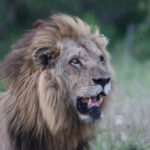The element that characterizes the lion as a predator is definitely the appearance of the herd hunting.
If the remarkable size, the strength, the extraordinary agility qualities are immediately apparent from the looks of these felines, the fact of hunting in the group further increases the success rates of an attack and the chances of knocking out a bigger prey.
From some studies on lion hunting behavior, it emerges that the percentage of successful attacks carried by individual specimens is about 16-17%, while if two or more lions hunt together they are effective in 30% of cases.
As for the prey, the most common are large ungulates, zebras, buffalos, etc, but a group of lions can hunt for any big herbivore, especially in cases where even the adult males join into the attack.
To confirm this, it has been shown that 75% of the feeding of a group of lions consists only of 4-5 species of abundant herbivores in the frequented area.
In addition, some lions’ herds, due to the specific conditions of their environment, have specialized in particular predatory behaviors, that do not take into account the enormous size of the prey. An example is the lions of the Savuti area in Botswana, who are effective elephant hunters and those of Lynianti, always in Botswana, skilled in hunting hippos.
But how do the hunting lions actually act?
9 out of 10 times are the only females to hunt, though members of a family can sometimes get themselves a prey, either alone or in smaller groups. As mentioned above, the number increases the chances of success and hunting actions have been documented involving more than 15 individuals.
However, unlike what is commonly thought of, the lion seldom hunts in ambush. This technique is generally limited to special occasions that determine the concentration of a large amount of herbivores, such as during the dry season near a water source, or similar occasions. In most cases, lions seek to approach the prey as much as possible, up to an optimum distance not exceeding 30 m.
At this point, thanks to a maximum speed that reaches 48-60 km / h, the attack is spun.

In the case of a herd, hunting individuals exhibit a high degree of collaboration and complex behavioral mechanisms.
The felines can aim to surround the prey, or arrange it in such a way as to push it towards other comrades in a more favorable position, or even manifesting a sort of division of roles in hunting. Certainly, these types of behaviors include components linked to learning and belong in a sense to the culture of the herd.
Lions land the largest prey by exploiting their own weight, so they kill them by suffocation, clutching the trachea between the mouths or shaking the muzzle from the nostrils.
Smaller animals are killed with a head or neck bite.











